Scouting for Balsam Woolly Adelgids
go.ncsu.edu/readext?792129
en Español / em Português
El inglés es el idioma de control de esta página. En la medida en que haya algún conflicto entre la traducción al inglés y la traducción, el inglés prevalece.
Al hacer clic en el enlace de traducción se activa un servicio de traducción gratuito para convertir la página al español. Al igual que con cualquier traducción por Internet, la conversión no es sensible al contexto y puede que no traduzca el texto en su significado original. NC State Extension no garantiza la exactitud del texto traducido. Por favor, tenga en cuenta que algunas aplicaciones y/o servicios pueden no funcionar como se espera cuando se traducen.
Português
Inglês é o idioma de controle desta página. Na medida que haja algum conflito entre o texto original em Inglês e a tradução, o Inglês prevalece.
Ao clicar no link de tradução, um serviço gratuito de tradução será ativado para converter a página para o Português. Como em qualquer tradução pela internet, a conversão não é sensivel ao contexto e pode não ocorrer a tradução para o significado orginal. O serviço de Extensão da Carolina do Norte (NC State Extension) não garante a exatidão do texto traduzido. Por favor, observe que algumas funções ou serviços podem não funcionar como esperado após a tradução.
English
English is the controlling language of this page. To the extent there is any conflict between the English text and the translation, English controls.
Clicking on the translation link activates a free translation service to convert the page to Spanish. As with any Internet translation, the conversion is not context-sensitive and may not translate the text to its original meaning. NC State Extension does not guarantee the accuracy of the translated text. Please note that some applications and/or services may not function as expected when translated.
Collapse ▲Scientific name: Adelges piceae
Where from: Introduced pest from Europe
Type of pest: Reduces growth because as the tree reacts to pest feeding by producing reaction wood that can eventually kill the tree.
Pest description:
-
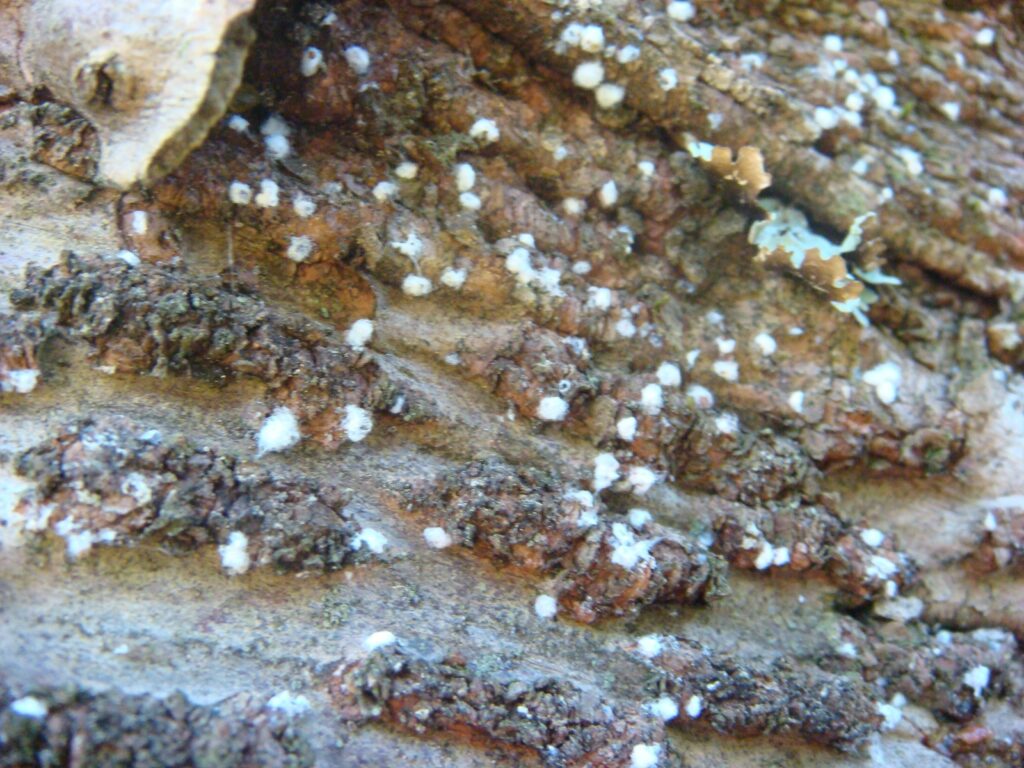
Balsam woolly adelgid on trunk
Adult stage can be seen with the naked eye as a white woolly covering. The wool protects a small, dark purple to black insect. Even though adults do not move, their six legs are still apparent under magnification. Often, there will be a dozen or more oblong, reddish-brown eggs behind the adult. All adults produced in North America are female and are found throughout the growing season, but not in the winter.
- Nymphs are small and require a magnifying lens to see. They are black with three rows of short, white rods along either side of the body and across the middle. Only the nymphs are found during the winter. They are also found throughout the rest of the year.
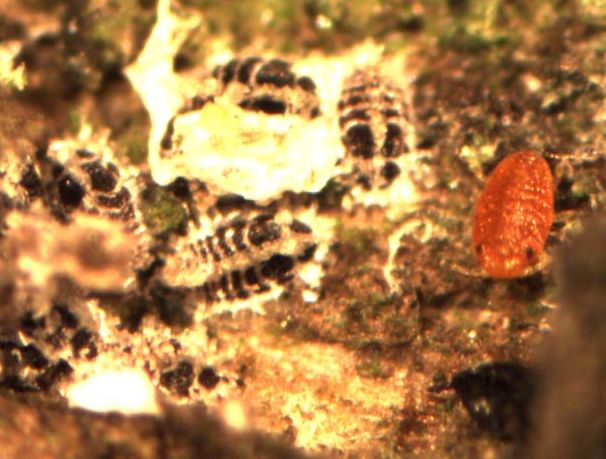
Balsam woolly adelgid nymphs and crawler
- Crawlers are occasionally found from April through October. They are the same color as the eggs with tiny black pin-points for eyes. They find a place on the tree to feed, and then settle into place, never moving again.
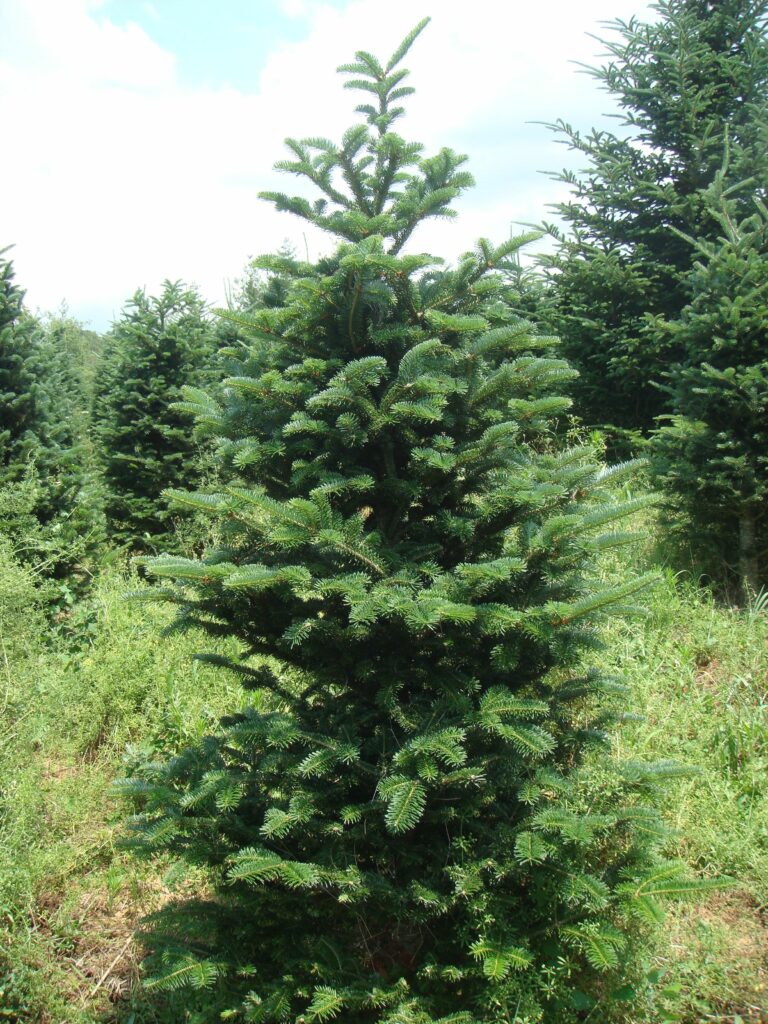
tree with crooked top due to balsam woolly adelgid
Tree damage:
- Often the first symptom that the tree has balsam woolly adelgid is a stunted terminal growing at an angle. This is the easiest symptom for the scout to find. Healthy tops should be straight after the new growth hardens off in July.
-
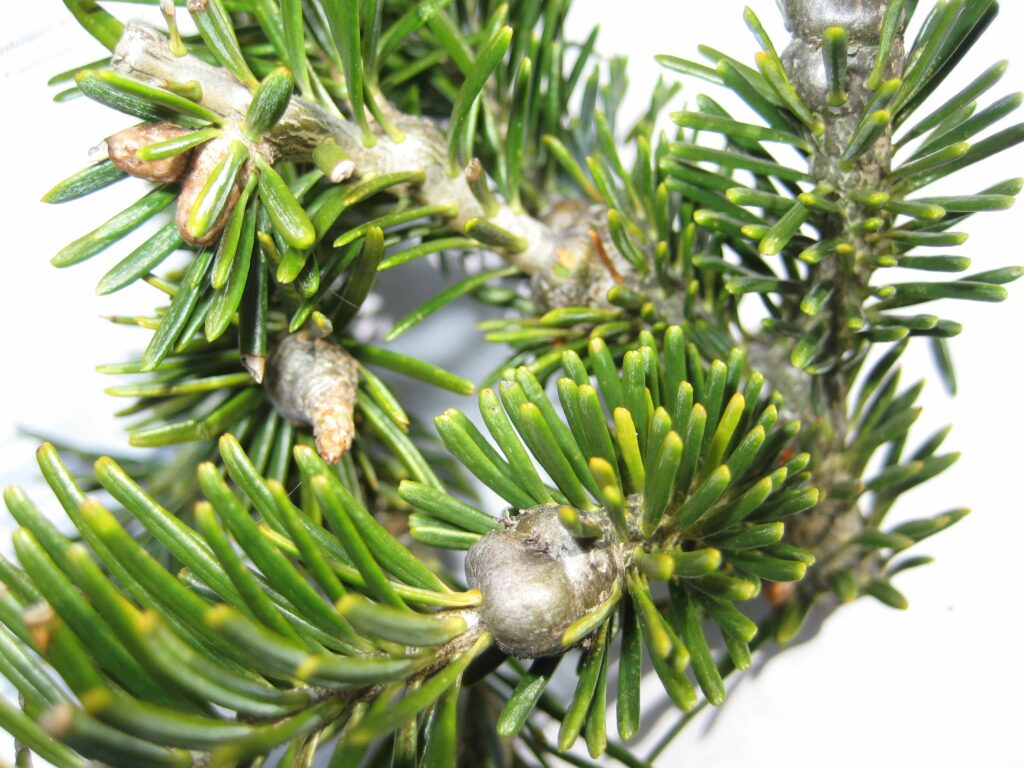
gouting caused by balsam woolly adelgid
Gouting is another symptom of balsam woolly adelgid feeding. The tissue around buds is swollen as well as where the shoot attaches to the branch.
- Shorter, weaker, and/or drooping new growth over most of the tree.
- Stiff trunks and branches. Infested trees are stiff and harder to rock back and forth.
- Dead branches and dead trees.
-

Fraser fir with reaction wood due to balsam woolly adelgid
The wood in the trunk is hard, brittle, and is reddish-brown instead of cream-colored. When the tree is cut down, this hard brittle wood is easily seen and felt as the tree is harder to saw through.
- Balsam woolly adelgids are only pests of true firs. Fraser fir is one of the most susceptible species.
Where found in the field: Balsam woolly adelgid typically starts near infested fir trees from natural stands, abandoned Christmas trees, yard trees or other untreated trees. Trees on ridges may be exposed first as crawlers are blown in.
Where found on the tree:
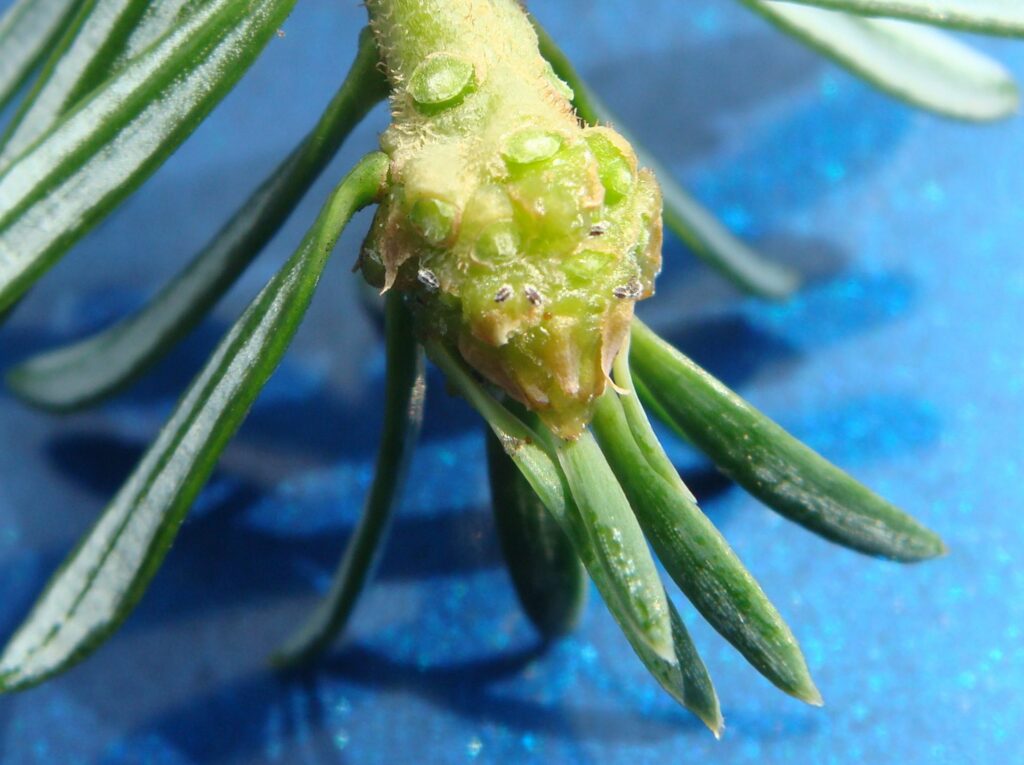
balsam woolly adelgid nymphs on bud
Balsam woolly adelgid can be found on tree buds and branches but are easiest to find on the trunk of the tree. They especially congregate under the branch/trunk union in the folds of the bark.
Scouting method:
- Teach shearing and tagging crews the symptoms of balsam woolly adelgid and have them mark problem trees.
- Examine closely any tree with a crooked top or dead branches. Push on the trunk of these trees at 4 to 5 feet off the ground to see if the trunk is stiff. Look on the tree trunk and branches to find the white wool of the adult female. The entire trunk should be examined with special attention to where the branch joins the trunk. To confirm the presence of the insect, remove any bark with white wool on it with a pocketknife and look at it with a magnifying lens.
- Scouting during the winter when adults aren’t present is harder. Look at shoots exhibiting gouting for the nymphs. These infested buds often appear to point downward.
- Flag heavily infested trees before treating. Wait at least one month following treatment to assess control. Rub your finger over white woolly masses to see if they are dead. If still alive, the smeared bodies of the insects will leave a purple stain. Bark samples can also be removed containing adelgids and examined under a microscope to determine if they are alive.
How weather affects: If it is dry and the trees are suffering from drought the trees are more likely to show symptoms such as dead branches and wilting.
How to develop treatment threshold: Any balsam woolly adelgid infested tree needs to be treated before the next growing season (next spring).
What can be confused with pest/damage:
- Lichen or dried sap can appear white on trunks. Look carefully with a magnifying lens to distinguish the white wool of the insect.
- Twig aphid eggs are the same size as balsam woolly adelgid nymphs at first glance, but adelgid nymphs have white waxy rods lined up in rows whereas on twig aphid eggs, they are randomly scattered around the egg.
- Improperly sheared trees can mimic balsam woolly adelgid damage. In a tree where multiple leaders are left, the uppermost top may appear weak and grow at an angle. One way to tell the difference is that a healthy tree has good growth and the trunk is limber. Look for the insect on the trunk of the tree.
Important natural predators: Many predators will feed on balsam woolly adelgid including lady beetles and hover fly larvae. However, though these predators do feed on adelgids, they will not clean up the problem. Since Fraser fir is so sensitive to this pest, predators cannot be relied on to give control.
For more information on balsam woolly adelgid including photographs and control recommendations, see Balsam Woolly Adelgid.
For the complete Fraser fir scouting manual for western North Carolina, see Scouting Manual.


